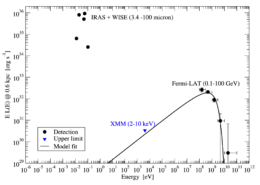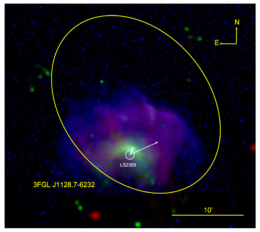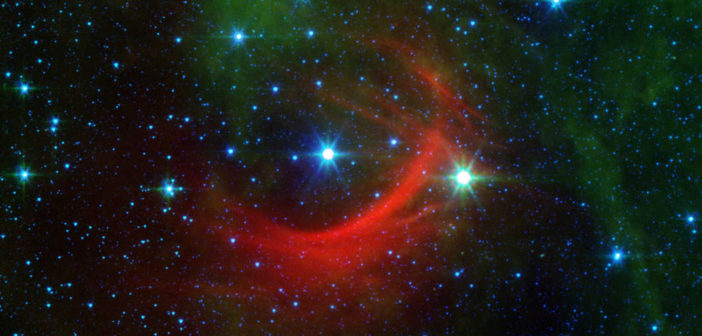The high-energy catalogs of the Fermi Large Area Telescope contain more than a thousand gamma-ray detections that have never been connected to a source. Some of these gamma rays could stem from very exotic objects: bow shocks of runaway stars.

An artist’s rendering of a blazar. These ultra-luminous objects — associated with the infall of material into a galaxy’s central black hole — are a common source of extragalactic gamma rays. [NASA/Goddard SFC Conceptual Image Lab]
A Shocking Way to Generate Gamma Rays
Runaway stars get their name by careening through interstellar space after being ejected from binary or multiple systems, usually because of gravitational interactions with other stars or a kick from a nearby supernova. As runaway stars plow into the surrounding interstellar medium, a bow shock can form in front of the star. It’s these stellar bow shocks that may be the sources of galactic gamma rays.
Stellar bow shocks generate gamma rays by first accelerating electrons to relativistic speeds. When a relativistic electron collides with a low-energy photon, it transfers energy to the photon, upgrading it to a gamma ray. This process, known as inverse Compton scattering, is the reverse of Compton scattering, through which electrons colliding with high-energy photons are accelerated to relativistic speeds.
Although stellar bow shocks are theoretically capable of producing gamma rays, these ultra-high-energy photons have never been definitively detected. Could the gamma rays from stellar bow shocks be hidden among the unidentified Fermi sources?

Comparison of modeled spectral energy distribution to observations for runaway star Lambda Cephei. Click to enlarge. [Sánchez-Ayaso et al. 2018]
Searching for Missing Gamma-Ray Sources
Estrella Sánchez-Ayaso (Universidad de Jaén, Spain) and collaborators embarked on a search for gamma-ray-emitting stellar bow shocks. They began by comparing the positions of unidentified Fermi sources to those of known bright stars in our galaxy and visually inspecting the matches for signs of a bow shock, which revealed two runaway star candidates.
Sánchez-Ayaso and collaborators then used the known properties of the two stars to determine whether or not it’s feasible for their bow shocks to be the source of the emission seen by Fermi. The authors modeled the gamma-ray emission generated by inverse Compton scattering of infrared photons off of electrons accelerated by the bow shocks.
By matching their model output to the Fermi observations, the authors determined that the physical conditions necessary for the two runaway stars to produce the observed gamma rays were reasonable. This suggests a promising link between the two stellar bow shocks — one of which was discovered as a result of this work — and two of the unidentified Fermi sources.

Fermi error ellipse overlaid on a composite radio, infrared, and optical image of runaway star LS 2355. [Sánchez-Ayaso et al. 2018]
Two Down, One Thousand to Go
With two of the Fermi sources potentially linked to runaway stars, can we expect more matches to be made? While runaway stars are relatively common, the conditions have to be just right for the stars to become gamma-ray sources. They must have very high velocities and be moving through a region of the interstellar medium that is dense and has a weak magnetic field, since electrons spiraling around magnetic field lines lose too much energy through synchrotron radiation to generate gamma rays through inverse Compton scattering.
While more observations are required to confirm that these two stars are the source of the gamma rays seen by Fermi, Sánchez-Ayaso and collaborators have shown that these unique stars are definitely worth exploring!
Citation
E. Sánchez-Ayaso et al 2018 ApJ 861 32. doi:10.3847/1538-4357/aac7c7

3 Comments
Pingback: Cuando las estrellas se dan a la fuga – Observatori Astronòmic
Pingback: Cuando las estrellas se dan a la fuga « SEDA / LIADA - RedLIADA - Cursos LIADA - Cielo del Mes - Fenómenos Astronómicos - RELEA
Pingback: Julio 2018 – Observatori Astronòmic